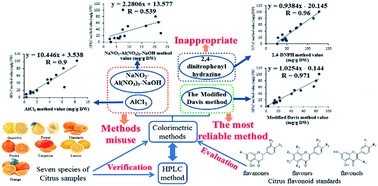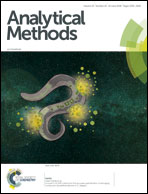Evaluation of colorimetric methods for quantification of citrus flavonoids to avoid misuse†
Abstract
The content of flavonoids is important for evaluating the quality of citrus-related products. However, due to the different characteristics of the structures of flavonoids and the lack of a universal method, many methods for quantification have been misused. Here, we used twenty-one citrus flavonoid standards to evaluate four widely used colorimetric methods, and seven species of citrus as natural samples were used to verify the evaluation. The results indicated that NaNO2–Al(NO3)3–NaOH and AlCl3 methods could only detect some of the flavonoids and were inadequate to estimate the total flavonoid content, and the 2,4-dinitrophenylhydrazine (2,4-DNPH) method might be affected by other carbonyl compounds in extracts. The Davis method was modified with naringin as the standard at a measuring wavelength of 420 nm for grapefruit and pomelo, and with hesperidin as the standard at a measuring wavelength of 360 nm for other species. It was proved to be the most reliable method for the quantification of citrus flavonoids and was also recommended for laboratories and factories where needed.



 Please wait while we load your content...
Please wait while we load your content...